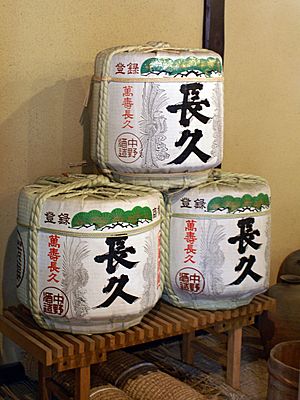Sake facts for kids
Sake is a special Japanese drink. In Japan, the word "sake" (pronounced 'sa.kɛ') means any alcoholic drink. But in English, "sake" means a specific kind of alcoholic drink made from rice. People in Japan often call this rice drink nihonshu (which means "Japanese alcohol") or just sake. This article will use "sake" to mean the rice drink, as it's known in English.
Contents
What is Sake Made From?
Sake is a fermented drink, which means it's made by letting tiny living things (like yeast) change sugars into alcohol. Most sake is made using four main things:
- Rice: Not just any rice! Special rice varieties are used for sake.
- Water: Good quality water is very important for sake.
- Kōji: This is a special mold (a type of fungus) that helps break down the rice starch into sugars.
- Yeast: This is what turns the sugars into alcohol.
Sometimes, a tiny bit of lactic acid is used when brewing. Also, a little water or pure alcohol might be added at the very end. Sake usually has about 15% or 16% alcohol, but it can range from 12% to 22%. Some cheaper kinds of sake might have added sugar or flavors.
How to Serve Sake
Sake is usually sold in bottles. Common sizes are 720 milliliters (about the size of a standard wine bottle) or 1.8 liters (a much larger bottle).
When people drink sake, they often pour it into small cups called chokko. Sometimes, sake is served in smaller bottles called tokkuri. A common serving size in a restaurant is 180 milliliters. People often share this amount. It's also common for people to pour drinks for each other, rather than pouring for themselves, when drinking sake together.
What is Amazake?
Amazake is a sweet drink that is related to sake. It has very little or no alcohol at all.
Related Pages
Images for kids
-
Sake barrel offerings at the Shinto shrine Tsurugaoka Hachiman-gū in Kamakura
-
A pair of sake flasks painted in gold and black lacquer. Momoyama period, 16th century.
-
Title page of Bereiding van Sacki, by Isaac Titsingh: earliest explanation of the sake brewing process in a European language. Published in 1781, in Batavia, Dutch East Indies.
-
Nigori, or unfiltered sake
See also
 In Spanish: Sake para niños
In Spanish: Sake para niños
















